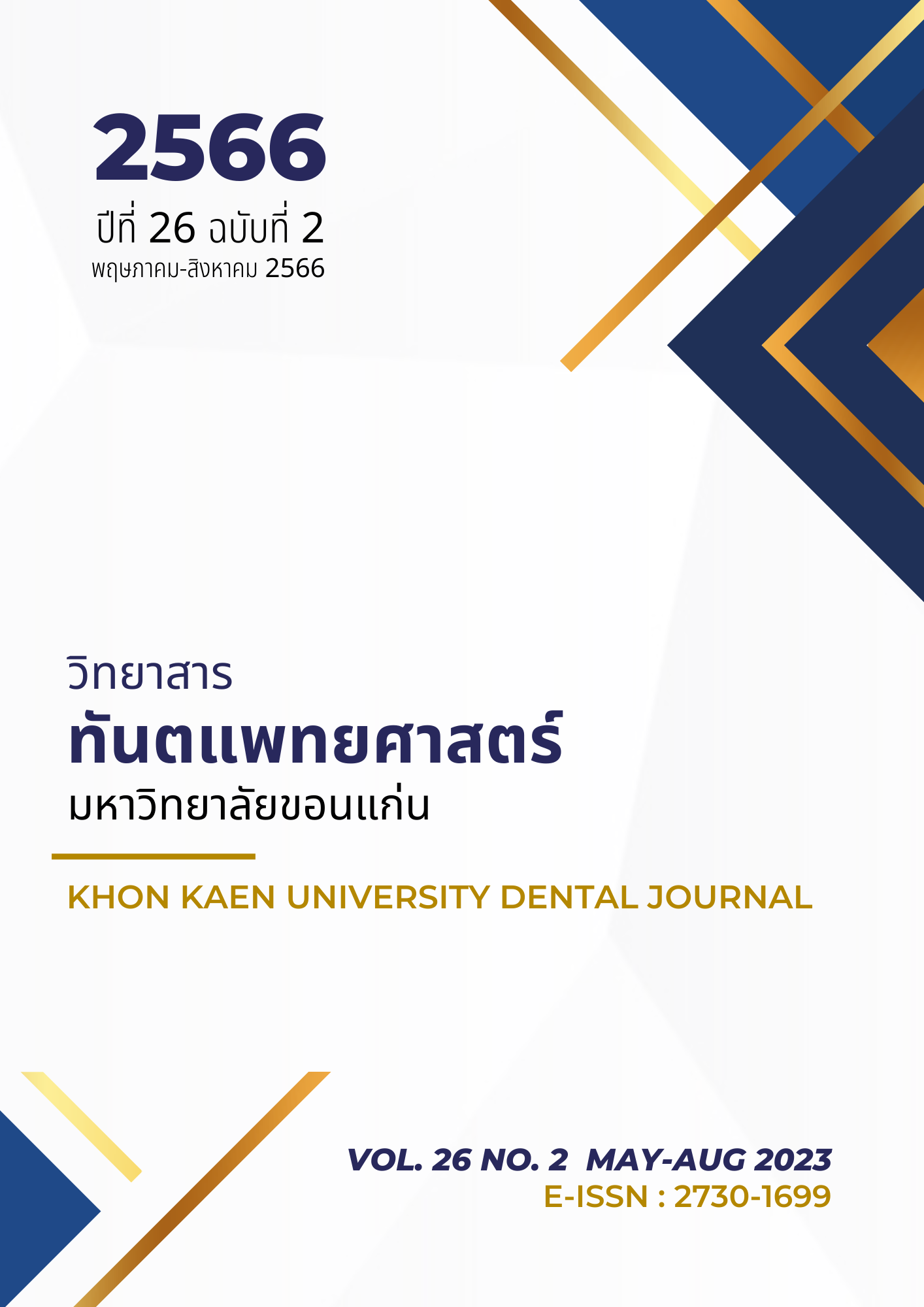Prevalence of Sodium Lauryl Sulfate Allergy and Association of Patch Testing of Sodium Lauryl Sulfate Allergy and Self-Reported Recurrent Aphthous Stomatitis in Thai Healthy Volunteers
Main Article Content
Abstract
The objectives of this study were to determine the prevalence of sodium lauryl sulfate (SLS) allergy in Thai healthy volunteers and investigate the association between SLS allergy and self-reported recurrent aphthous stomatitis (RAS) history. This study collected data from 71 Thai healthy participants at the Faculty of Dentistry, Prince of Songkla University. Eligible participants received 0.5% SLS and distilled water (negative control) patch testing on the forearm for 48 hours. Twenty-four hours after removal of the patch testing, participants were recalled for a test interpretation. In addition, participants were also requested to respond to the baseline characteristics and related history of RAS, including the presence of RAS and the number, size, duration, frequency, location, prodromal symptoms, family history, and stress related to RAS. Descriptive statistics described baseline characteristics, characteristics of RAS, SLS allergy interpretation, and prevalence of SLS allergy among Thai healthy subjects. Fisher’s exact test was used to determine the association between SLS allergy and RAS history. The results showed that the prevalence of SLS allergy was 81.82% in Thai healthy subjects. The subjects with a history of RAS were mainly female, usually presenting one RAS ulcer with ≤ 5 mm size of ulcer located on non-keratinized mucosa, of less than one week in duration, occurring over three times per year, presenting prodromal symptoms, and being related to family history. All subjects with a history of RAS were 100% positive for SLS allergy; in contrast, subjects without a history of RAS were 67.74% positive for SLS. A significant association was found between SLS allergy and self-reported RAS history (p=0.003). However, no significant association between the scoring level of SLS allergic reactions and self-reported RAS history was found. In conclusion, SLS allergy is associated with self-reported RAS events. Therefore, SLS allergy should be considered as one factor in patients with a history of RAS.
Article Details

This work is licensed under a Creative Commons Attribution-NonCommercial-NoDerivatives 4.0 International License.
บทความ ข้อมูล เนื้อหา รูปภาพ ฯลฯ ที่ได้รับการลงตีพิมพ์ในวิทยาสารทันตแพทยศาสตร์ มหาวิทยาลัยขอนแก่นถือเป็นลิขสิทธิ์เฉพาะของคณะทันตแพทยศาสตร์ มหาวิทยาลัยขอนแก่น หากบุคคลหรือหน่วยงานใดต้องการนำทั้งหมดหรือส่วนหนึ่งส่วนใดไปเผยแพร่ต่อหรือเพื่อกระทำการใด ๆ จะต้องได้รับอนุญาตเป็นลายลักษณ์อักษร จากคณะทันตแพทยศาสตร์ มหาวิทยาลัยขอนแก่นก่อนเท่านั้น
References
Akintoye SO, Greenberg MS. Recurrent aphthous stomatitis. Dent Clin North Am 2014;58(2):281-97.
Cui RZ, Bruce AJ, Rogers RS 3rd. Recurrent aphthous stomatitis. Clin Dermatol 2016;34(4):475-81.
Zain RB. Oral recurrent aphthous ulcers/stomatitis: prevalence in Malaysia and an epidemiological update. J Oral Sci 2000;42(1):15-9.
Akay GA, Yalçınkaya E, Yazici H. Evaluation of skin patch test results and allergen elimination in patients with idiopathic recurrent aphthous stomatitis. Turk Klin Dermatoloji 2016;26(2):76-80.
Gülseren D, Hapa A, Ersoy-Evans S, Elçin G, Karaduman A. Is there a role of food additives in recurrent aphthous stomatitis? A prospective study with patch testing. Int J Dermatol 2017; 56(3):302-6.
Ozden HK, Selcuk AA. Is there a role of toothpastes in the development of recurrent aphthous stomatitis? A prospective controlled clinical trial with skin patch testing. Oral Surg Oral Med Oral Pathol Oral Radiol 2021;131(1):43-8.
Geier J, Uter W, Pirker C, Frosch PJ. Patch testing with the irritant sodium lauryl sulfate (SLS) is useful in interpreting weak reactions to contact allergens as allergic or irritant. Contact Dermatitis 2003;48(2):99-107.
Alli BY, Erinoso OA, Olawuyi AB. Effect of sodium lauryl sulfate on recurrent aphthous stomatitis: A systematic review. J Oral Pathol Med 2019;48(5): 358-64.
Shim YJ, Choi JH, Ahn HJ, Kwon JS. Effect of sodium lauryl sulfate on recurrent aphthous stomatitis: A randomized controlled clinical trial. Oral Dis 2012;18(7):655–60.
Cheng LL. Limited evidence suggests that patients with recurrent aphthous stomatitis may benefit from using sodium lauryl sulfate-free dentifrices. J Evid Based Dent Pract 2019;19(4):101349.
Healy CM, Paterson M, Joyston-Bechal S, Williams DM, Thornhill MH. The effect of a sodium lauryl sulfate-free dentifrice on patients with recurrent oral ulceration. Oral Dis 1999;5(1):39-43.
Pongissawaranun W, Laohapand P. Epidemiologic study on recurrent aphthous stomatitis in a Thai dental patient population. Community Dent Oral Epidemiol 1991;19(1):52-3.
Löffler H, Pirker C, Aramaki J, Frosch PJ, Happle R, Effendy I. Evaluation of skin susceptibility to irritancy by routine patch testing with sodium lauryl sulfate. Eur J Dermatol 2001;11(5):416-9.
Aramaki J, Löffler C, Kawana S, Effendy I, Happle R, Löffler H. Irritant patch testing with sodium lauryl sulphate: interrelation between concentration and exposure time. Br J Dermatol 2001;145(5):704-8.
Uter W, Geier J, Becker D, Brasch J, Löffler H. The MOAHLFA index of irritant sodium lauryl sulfate reactions: first results of a multicentre study on routine sodium lauryl sulfate patch testing. Contact Dermatitis 2004;51(5-6):259-62.
Löffler H, Becker D, Brasch J, Geier J, German Contact Dermatitis Research Group (DKG). Simultaneous sodium lauryl sulphate testing improves the diagnostic validity of allergic patch tests: Results from a prospective multicentre study of the German Contact Dermatitis Research Group (Deutsche Kontaktallergie-Gruppe, DKG). Br J Dermatol 2005;152(4):709-19.
Schwitulla J, Brasch J, Löffler H, Schnuch A, Geier J, Uter W. Skin irritability to sodium lauryl sulfate is associated with increased positive patch test reactions. Br J Dermatol 2014;171(1):115-23.
Wahlberg JE. Patch testing. In: Rycroft RJG, Menné T, Frosch PJ, Leppoittevin J-P, editors. Textbook of contact dermatitis. 3rd ed. Springer: Berlin Heidelberg;2001. 435–68.
Isobe T, Kato Y, Okubo Y, Koga M. Evaluation of patch testing in atopic dermatitis using commercially available environmental antigens. Allergol Int 2001;50(2):153-62.


